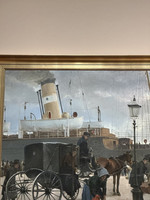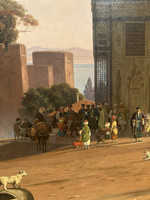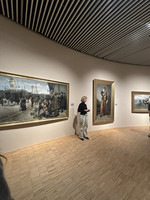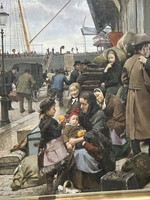Game Log 1 – Experience




Team members and Roles:
After using the Empowered Participation method we assigned the roles based on preferences and experience.
Mai: Gamemaster, Storyteller
Linn Emilie: Designer
Selma: Artist
Shared role: Crafter
Artwalk:
Using the Culture Safari method, we explored various artworks. Three pieces stood out:
- A national romantic landscape painting, evoking serenity and an idealized view of nature.
- A vibrant painting from Constantinople, depicting a dancing bear amid an engaged crowd.
- A somber depiction of Danish emigrants preparing to sail to America, symbolizing hope intertwined with hardship.
These artworks gave us inspiration for our game ideas.
Game ideas:
How did we use the ideation wheel?
We utilized the Ideation Wheel to explore cultural themes, game types, and European values for each game concept.
Reflecting on how cultural heritage can shape game design, we believe integrating heritage creates emotional resonance, educates players, and encourages critical thinking about historical and contemporary issues. Cultural heritage in games should foster empathy and inspire societal reflection or change.
After the culturestorming session, we were left with our three best ideas:
- 1) Still/Shift: Players experience a visually romanticized world that distorts as they move, revealing historical and social realities. Standing still restores idealization, but progress demands confronting challenging truths.
- 2) Collecting oranges: Players collect oranges, symbolizing dreams on a migration journey, facing symbolic and real-world obstacles reflecting human dignity and freedom.
- 3) Dance with the Bear: A rhythmic game where players dance with a bear inspired by a historical painting, promoting democracy and respect for human rights through inclusive cultural participation.
For the game Still/shift (idea 1):
- Cultural/Societal Theme (Yellow) → Rewriting History/Reality: Challenges the romanticized view of nature and history, revealing hidden or ignored truths beneath stillness.
- Cultural Heritage Focus (Blue) → Cultural Aesthetics: Leverages the beauty of romantic visuals, then disrupts them to reveal underlying realities—using art style as commentary..
- Game Type (Pink) → Explorative/Narrative (can be interpreted from Puzzle/Adventure)Movement through the landscape changes perception, discovery through interaction. Less goal-oriented, more about perspective.
- EU Value (Purple) → Freedom & Rule of Law: Encourages players to question the “truth” of their surroundings and reflect on freedom of thought, expression, and accountability in how histories are told.
For the game with collecting Oranges over the ship to America (Idea 2):
- Cultural/Societal Theme (Yellow) → Reimagining Utopian/Dystopian Futures: The journey symbolizes both hope and uncertainty.
- Cultural Heritage Focus (Blue) → Cultural Gameworlds: The ship represents cultural diversity and migration.
- Game Type (Pink) → Puzzle/Adventure: Players actively navigate challenges.
- EU Value (Purple) → Human Dignity: Emphasizing equality and shared human worth regardless of socioeconomic status.
For the game with Dancing with the Bear" (idea 3):
- Cultural/Societal Theme (Yellow) → Remixing Heritage/History: The game reinterprets a historical spectacle into a modern, participatory, and inclusive dance experience.
- Cultural Heritage Focus (Blue) → Cultural Gameplay: The act of dancing becomes a form of cultural interaction; performance as heritage, and the player becomes part of that.
- Game Type (Pink) → Rhythm/Art: Players participate in timed inputs or expressive movement, creating a co-performance with the bear.
- EU Value (Purple) → Democracy & Respect for Human Rights: Reframes the bear not as an exploited figure but as a respected participant; emphasizes inclusion, freedom of expression, and cultural pluralism.
AAR-Project Group 6
| Status | Prototype |
| Authors | MaiRicaplaza, linnemilie |
More posts
- Game Log 3 - IMAGINE1 day ago
- Game Log 2 - PLAY19 days ago
Leave a comment
Log in with itch.io to leave a comment.